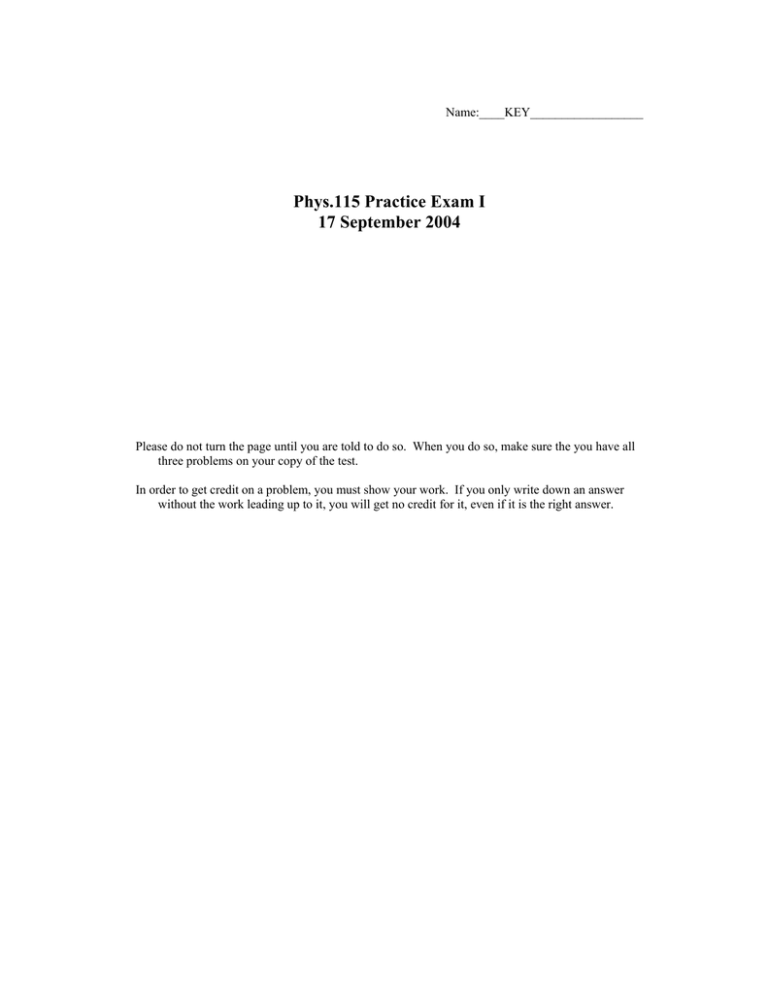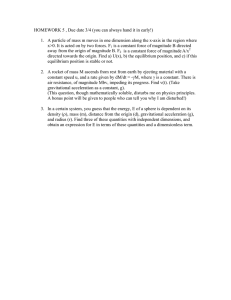Practice Exam 1 Key
advertisement

Name:____KEY__________________ Phys.115 Practice Exam I 17 September 2004 Please do not turn the page until you are told to do so. When you do so, make sure the you have all three problems on your copy of the test. In order to get credit on a problem, you must show your work. If you only write down an answer without the work leading up to it, you will get no credit for it, even if it is the right answer. 1. A tennis ball is shot vertically upward in an evacuated chamber with an initial speed of 20.0 m/s at time t = 0 s. a.(5 points) How high does the ball rise? v 2f y = vi2y + 2a∆y = vi2y + 2a ( y − y0 ) ; y0 = 0 and v f y = 0 y= − vi2y 2a = − (20.0 m/s) 2 = 20.4 m 2(−9.80 m/s 2 ) b.(5 points) Approximately how long does it take the tennis ball to reach its maximum height? v f y = vi y + at t= v f y − vi y a = 0 − 20.0 m/s = 2.04 s − 9.80 m/s 2 c.(5 points) Determine the velocity of the ball at t = 3.00 seconds. v3 s = vi + at = 20.0 m/s + (−9.80 m/s 2 )(3.00 s) = −9.40 m/s (magnitude: 9.4 m/s; direction: down) d.(5 points) What is the magnitude of the acceleration of the ball when it is at its highest point? The magnitude of the acceleration of the ball is 9.80 m/s2 throughout its motion. 2. A projectile is fired horizontally with an initial speed of 50.0 m/s. Neglect air resistance. a.(7 points) What is the magnitude of the displacement of the projectile 3.00 s after it is fired? x = vi x t = (50.0 m/s)(3.00 s) = 1.50 × 10 2 m 1 1 y = y0 + vi y t + a y t 2 = 0 + 0 + (−9.80 m/s 2 )(3.00 s) 2 = −44.1m 2 2 d = x 2 + y 2 = (1.50 × 102 m) 2 + (−44.1m) 2 = 156 m b.(7 points) What is the speed of the projectile 3.00 s after it is fired? v3 s y = vi y + a y t = 0 + (−9.80 m/s2 )(3.00 s) = −29.4 m/s vx = 50.0 m/s v = vx2 + v y2 = (−29.4 m/s) 2 + (50.0 m/s) 2 = 58.0 m/s c.(6 points) What is the magnitude of the acceleration of the projectile 3.00 s after it is fired? The magnitude of the acceleration of the ball is 9.80 m/s2 throughout its motion. 3. A 10-kg block is connected to a 40-kg block as shown in the figure. The surface on which the blocks slide is frictionless. A force of 50 N pulls the blocks to the right. T 10 kg 50 N 40 kg a.(5 points) What is the magnitude of the acceleration of the 40-kg block? ∑F x a= = (m1 + m2 )a ∑F x (m1 + m2 ) = 50 N = 1m/s2 10 kg + 40 kg b.(5 points) What is the magnitude of the tension T in the rope that connects the two blocks? FN T W ∑F x = m1a T = m1a = (10 kg)(1 m/s 2 ) = 10 N c.(5 points) The sliding blocks encounter a surface that has a coefficient of kinetic friction of 0.10 and a coefficient of static friction of 0.50. What is the magnitude of the acceleration of the blocks? FN F fk W ∑F y = 0; FN − W = 0; ⇒ FN = W = mg f k = µ k FN = µ k mg ∑ Fx = ma; F − f k = ma; a = F − f k F − µ k mg 50 N − (0.10)(50 kg )(9.8 m/s2 ) = = = 0.02 m s 2 50 kg m m d.(5 points) If the 50-N force is now oriented at 75° with respect to the horizontal, will it be strong enough to pull the two blocks if they are initially stationary? Please explain your reasoning using the necessary equations. (There still is friction between the blocks and the surface.) F FN fs W ∑F y = 0; ⇒ FN + F sin θ − W = 0 f s = µ s FN = µ s (W − F sin θ ) = (0.50)[(50 kg)(9.8 m/s 2 ) − (50 N) sin 75°] = 220 N The horizontal pulling force is Fx = F cosθ = (50 N ) cos 75° = 13 N The static friction overcomes the horizontal pulling force, so the blocks won’t move.


